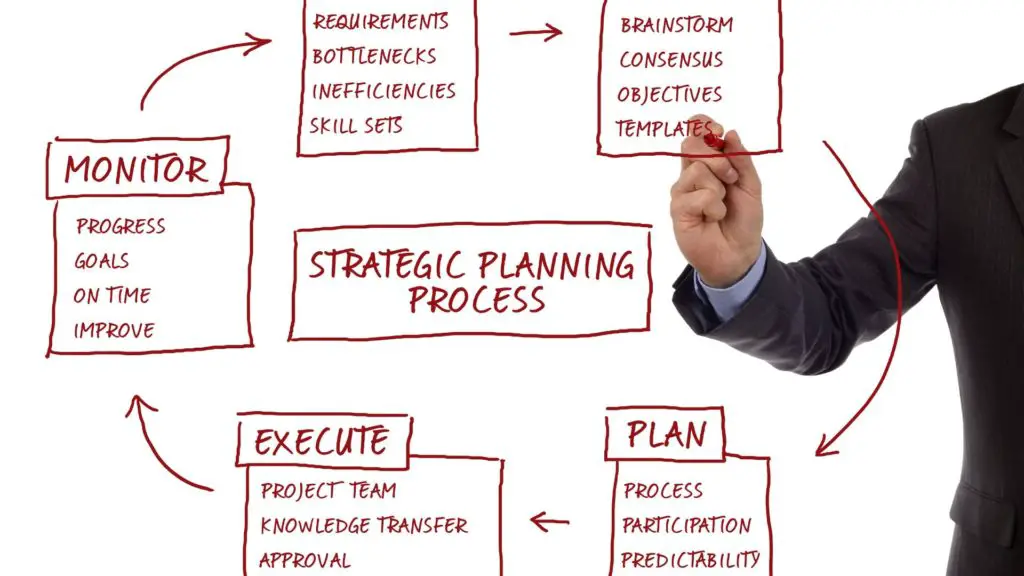What is Strategic Management?
Every business strategize. It is an essential management process to strategize and prepare for different odds. Strategy in the simple sense of the word is a plan designed to achieve an objective and planning as we all know is the primary function of management that lays down the base for the entire business.
Strategic management in essence is a fancy name given to the planning process in action. It involves the creation and execution of the major goals agreed upon by the top-level management of a business.
Strategic management can also be observed as the set of decisions undertaken by a manager impacting the results of the organization’s competitive performance. Detailed analysis of the available information and creative utilization of resources (may not be unique) is necessary for making important strategic decisions.
While making strategic decisions, significant planning is required for both predictable scenarios as well as unpredictable situations.
Wikipedia defines Strategic management as,
“Strategic management involves the formulation and implementation of the major goals and initiatives taken by a company’s top management on behalf of owners, based on consideration of resources and an assessment of the internal and external environments in which the organization competes.”
Strategic Management Process
Every successful organization must have a clear strategy in place. A strategy determines the basic short/long-term goals and objectives of an organization, the course of action to achieve the goals, and the resources necessary for carrying out those goals. By following the strategic management process an enterprise can easily plan for its success.
The Five Stages of the Strategic Management Process
1. Goal Setting
Clarify the vision for your business by setting clear goals. Where do we want to be? This is the first question to be asked in a strategic planning process. Once you have come up with clear goals, write a mission statement that tells your employees and shareholders these plans.
For example, the Microsoft vision 30 years ago was “a computer on every desk”. Goals can be created by Founders and CEO of a company and communicated downwards or by a process involving all members of an organization.
2. Situation Analysis
Once you have the vision of the company gather the information that will help you accomplish your goals. A good place to start is by doing a SWOT analysis. Here you look at the organizations,
- Strengths– These are things a company is good at doing or characteristics that give it enhanced competitiveness e.g., physical assets, intangible assets, etc.
- Weaknesses– These are what a company lacks, does poorly or a condition that puts it at a disadvantage. A weakness represents a company’s competitive liability.
- Opportunities– An opportunity is that which enables a company to excel in achieving its objectives. It is external to the organization and can be a source of growth, profitability, or gaining a competitive advantage.
- Threats– These are factors that could inhibit a company’s ability to achieve its targets. They inhibit growth, profitability, erode competitive advantage, and are also external to the organization.
When doing a SWOT Analysis, you look at both External (macro-environment, industry, competition, customers) and internal factors (resources, culture, competencies). The external analysis aims to identify opportunities and threats in the environment. The internal analysis identifies the strengthens and weaknesses of the organization.
3. Strategy Formulation
Once you have discovered your strengthens, weaknesses, opportunities, and threats you can begin creating your strategy. Strategy Formulation entails coming up with both long and short-term goals. In this phase, you need to answer four key questions.
- Where are you now?
The SWOT analysis will help you answer this question.
- Where do you want to go?
You answer this by outlining the future desired position of the company.
- How do you get there?
Come up with sets of activities to be pursued towards the realization of objectives. Use SWOT to identify possible strategies by building on strengthens, resolving weaknesses, exploiting opportunities, and avoiding threats.
- How will you know you’ve got there?
Answering this question means developing a mechanism on how to monitor the strategy you decide on.
Answering those questions will give you a clear strategy for your company.
4. Strategy Implementation
once you’re done with the strategy formulation it is now time for action. A strategy must be put into action for it to deliver results otherwise it will be just another document. Implementation happens to be a more challenging and delicate task than strategy formulation.
Some delicate and sensitive issues involved at this stage are resource mobilization, restructuring, cultural changes, leadership changes, etc. To operationalize the new strategy, you need to ensure daily activities, work efforts and resources are directed fully toward implementing the strategy. A typical action plan would entail having
- Objectives (i.e. operational objectives)
- Activities
- Timeframe
- Person responsible
- Budget
Implementing the strategy, therefore, involves recasting and translating the strategy into shorter time frames appropriate for implementation. The culture and leadership of the organization may have to change to be compatible with the strategy being implemented.
Given that strategy, implementation will definitely face hurdles consider having a strategy and reward system. The reward system should match the strategy so as to motive its execution. Rewards can take various forms such as promotions, salary increments, bonuses, awards, and so on.
Actions that are consistent with strategy implementation should be rewarded. Such actions could include attitudes, behavior, or performance that fosters the accomplishment of strategic objectives.
5. Strategy Evaluation
This is the final stage of the strategic management process. At this stage, your strategy is already in action and you need to measure the effectiveness of the strategy. Measure the progress by comparing the plan against actual results.
If the company is properly implementing its strategy results should be as expected in the strategy or not far off. If results are below par something is wrong with the implementation and corrective actions should be taken.
At the evaluation, the key thing is the feasibility of the strategy. Check if the resources required to implement the strategy are available, can be developed or obtained. Resources include funding, people, time, and information. Tools used to evaluate feasibility include cash flow analysis and forecasting, break-even analysis, and resource deployment analysis.






